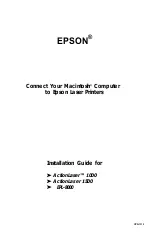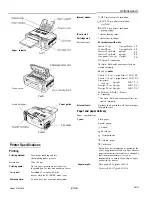
X e r o x N u v e r a P a p e r G u id e
1-9
S e l e c t i n g s t o c k f o r y o u r X e r o x N u v e r a S y s t e m
to the lead (left side) edge of the tray so it will bend easier as it
moves through the system. Load middleweight papers with the
grain in either direction. The weight ranges for the Xerox Nuvera
Production and Perfecting Systems are displayed in
Table 1-6.
Determining grain direction
One way to determine the grain is to fold a sheet of paper
lengthwise, then make a crosswise fold. Cross-grain folds tend to
be more rough and cracked as shown in
Figure 1-1.
Figure 1-1. Fold with and against grain
Another method you can use to determine the grain direction is to
tear a sheet. Paper always tears straighter with the grain.
Figure 1-2. Tear with and against grain
You can also allow 4 inches (100 millimeters) of the short edge of
a sheet and 4 inches (100 millimeters) of the long edge of a sheet
hang over the edge of a table as seen in
Figure 1-3.
The sheet
hangs lower (bends more) with the grain parallel to the table edge.
Table 1-6. Paper weight ranges
Paper type
Weight range in gsm
Normal (Light)
weight
56 to 84 gsm uncoated bond
56 to 84 gsm uncoated offset
Medium weight
85 to 105 gsm uncoated
Heavy weight
106 to 220 gsm uncoated
140 to 220 gsm coated
Summary of Contents for 288 Digital Perfecting System Paper
Page 6: ...Xerox Nuvera Paper Guide iv Table of Contents ...
Page 10: ...Xerox Nuvera Paper Guide viii Introduction ...
Page 22: ...Xerox Nuvera Paper Guide 1 12 Selecting stock for your Xerox Nuvera System ...
Page 34: ...Xerox Nuvera Paper Guide 2 12 Managing your paper supply ...
Page 50: ...Xerox Nuvera Paper Guide 3 16 Tips by stock type ...
Page 64: ...Xerox Nuvera Paper Guide C 4 Managing the feed modules ...
Page 78: ...Index Index 4 Xerox Nuvera Paper Guide ...
Page 79: ......
Page 80: ......
















































